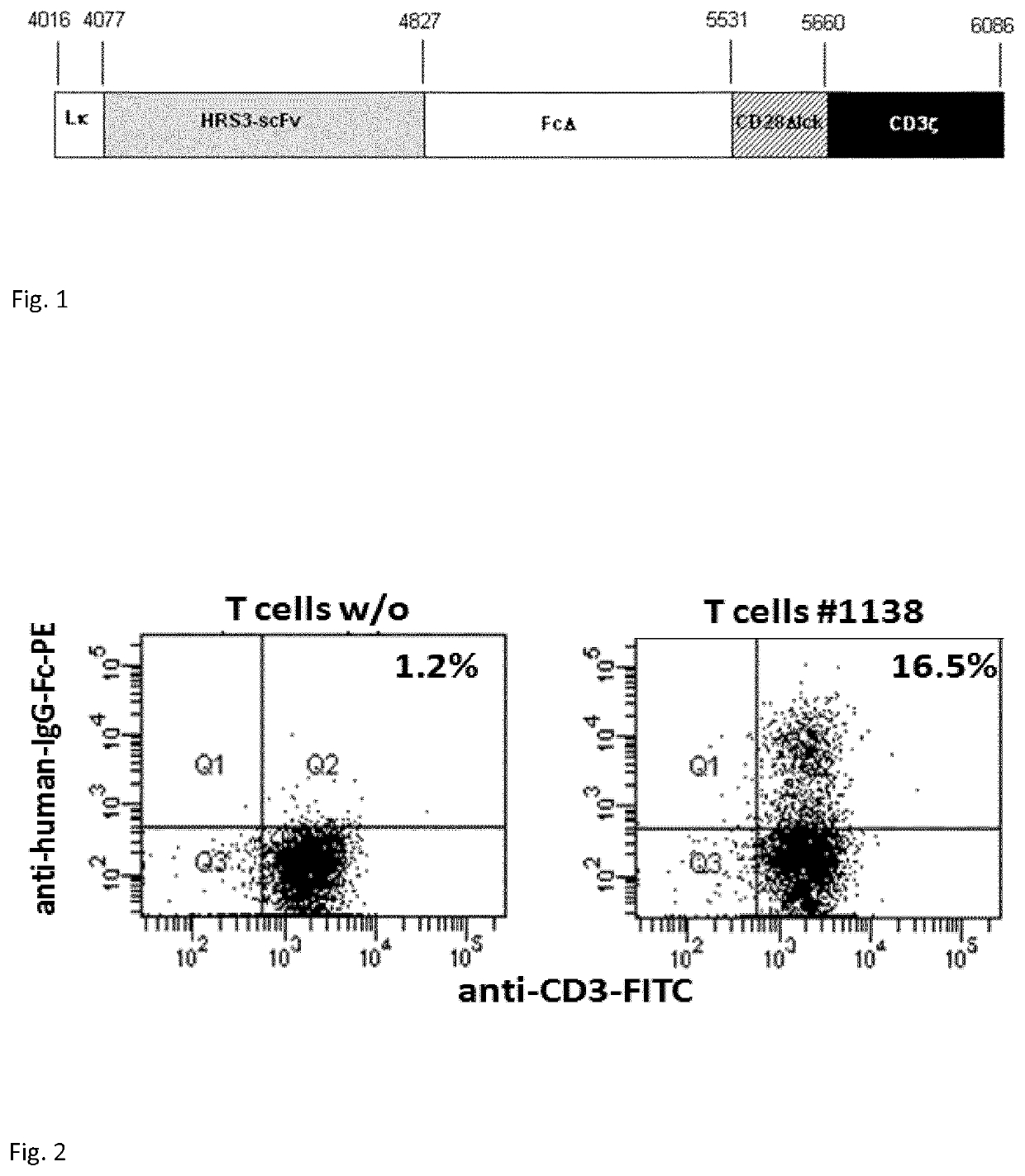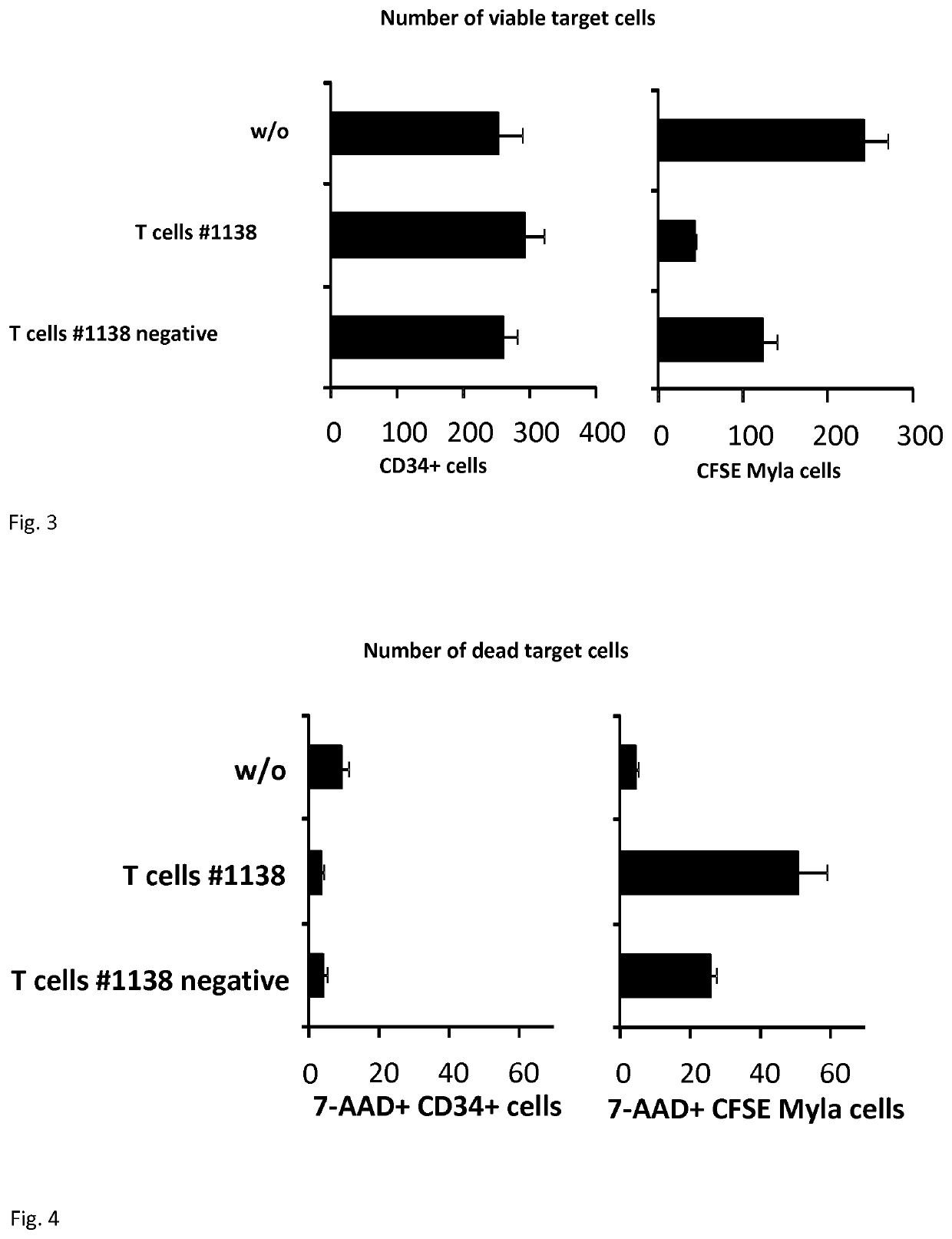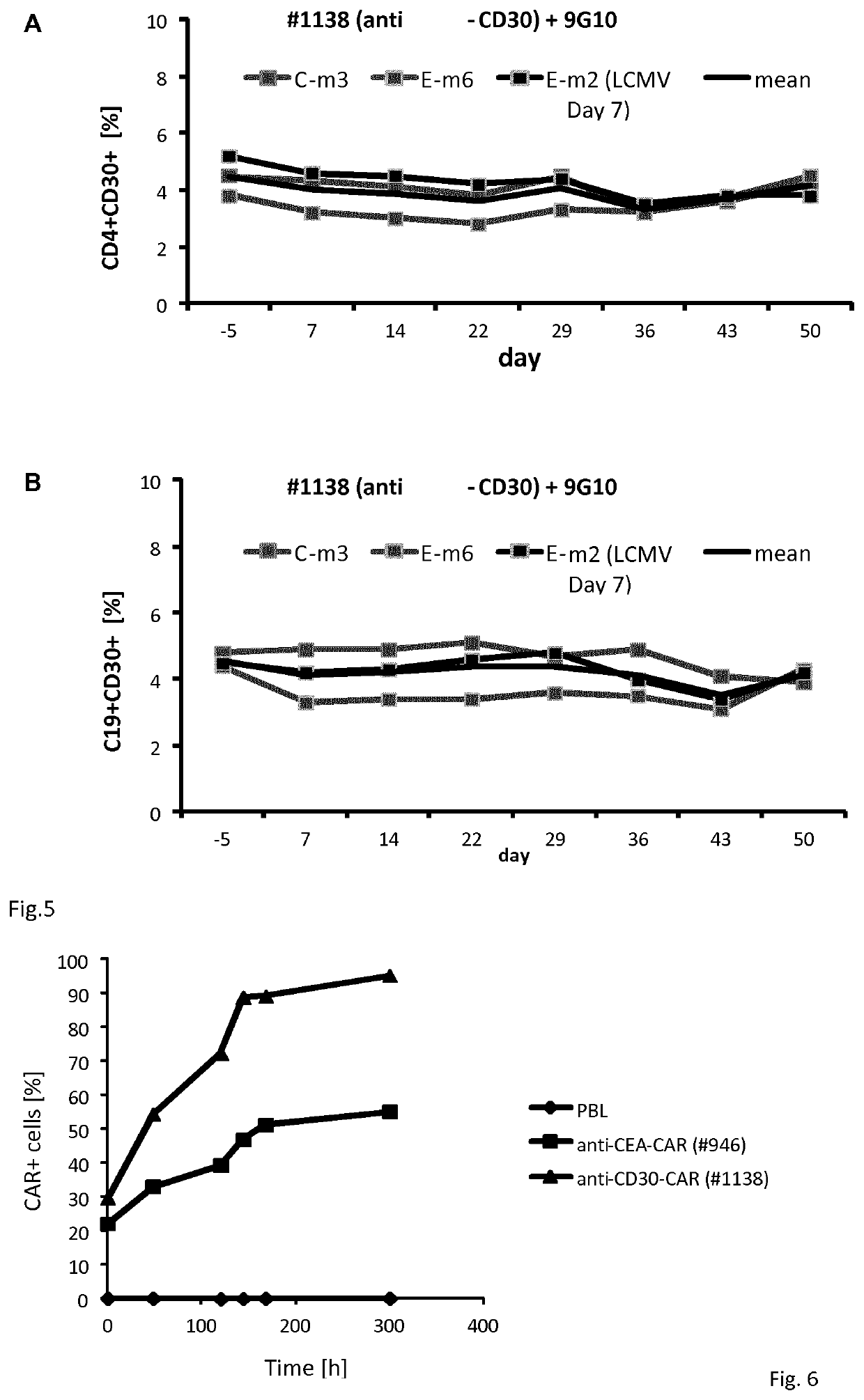Anti CD30 chimeric antigen receptor and its use
a technology of chimeric antigen receptor and chimeric antigen, which is applied in the direction of drug composition, antibody medical ingredients, fusions for specific cell targeting, etc., can solve problems such as achieve the development of a favourite cd30 chimeric antigen receptor, improve persistence, survival and proliferation of car t-cells, and minimize side effects on healthy tissues
- Summary
- Abstract
- Description
- Claims
- Application Information
AI Technical Summary
Benefits of technology
Problems solved by technology
Method used
Image
Examples
example 2
Activity of CAR #1138 Engineered T-Cells Toward Healthy Human B- and T-Cells in a Mouse Model
Dose Selection
[0069]Human CD34+ hematopoietic stem cells were isolated from cord blood. New born Rag2− / − common gamma chain− / − mice were transplanted with 3×105 CD34+ hematopoietic stem cells to engraft the human hematopoietic system. Successfully engrafted animals were transplanted with 2.5×106 T-cells per mouse by a single injection into the tail vein.
Animals / Animal Maintenance
[0070]Species: Mouse[0071]Strain / Stock: Rag2− / − cγ− / −[0072]Selection of species: The T- and B-cell deficient mouse model was used to engraft the human hematopoietic system; the reconstituted hematopoietic system closely mimics the human situation.
Identification of Animals
[0073]
TABLE 1123456789101112131415161718192021A-A-A-B-B-B-C-C-C-C-D-D-D-D-E-W-E-E-E-E-E-w1w2m1w1w2m1w1w2m1m3w1m1m1m2w1m1m2m3m4m5m6Table 1A-E = breeding group;m = malew = female;1-6 mouse number
Transplantation of Human Hematopoiesis
[0074]Rag2− / − cγ− / −...
example 3
Expansion of #1138 CAR Modified T-Cells
Engineering of T-cells with CAR #1138 and #946
[0096]Engraftment of human peripheral T-cells with #1138 and for comparison #946 CAR, see Hombach A, et. Al., Gene Ther. 2010 October; 17(10):1206-13. doi: 10.1038 / gt.2010.91. Epub 2010 Jun. 17, harbouring a CEA-specific scFv binding domain CEA was assessed by two colour FACS after 12 hrs after transduction. The initial efficiency was 29% for #1138 CAR and 22% for #946 CAR T-cells, respectively.
Monitoring T-Cells with CAR #1138 and #946
[0097]After transduction cells were cultured in Xvivo15 medium supplemented with 10% FCS and IL-2 (500 U / ml). Medium was replaced once a week, IL-2 was added every 3rd day. A sample of cells was removed at different time points and CD3+ T-cells were analyzed for CAR expression utilizing FITC-conjugated anti-mouse and PE-conjugated anti-human IgG1 Fc antibodies. Data are summarized in FIG. 6.
CONCLUSIONS
[0098]The number of #1138 CAR T-cells increased substantially durin...
example 4
Cytolysis of B-Cells
[0099]As shown in FIG. 7a, B-cells were isolated from PBMC according to standard procedures. In addition, T-cells were isolated from PBMC, grafted with CAR #1138, CFSE-labeled and separated into CAR+ and CAR− populations. The autologous B-cells were activated for 96 h by sCD40L / IL-4 according to standard procedures, labelled with PKH26 and sorted into CD30+ and CD30− populations by flow cytometry based cell sorting. Labelled T-cells were co-cultivated (2.5×104 / well) for 24 h with B-cells, recovered, stained with 7-AAD and analysed by flow cytometry. For control, target cell lysis of Myla cells representing malignant T-cells was determined by a XTT-based viability assay. As shown in FIG. 7B, there is no significant cytolysis of CD19+ B-cells by CAR+ or CAR− T-cells whereas a substantial cytolysis of CD30+ Myla cells occurred when co-incubated with #1138 CAR T-cells. Moreover, there is no substantial difference in cytolysis of CD30+ and CD30− cells of the CD19+ B-c...
PUM
| Property | Measurement | Unit |
|---|---|---|
| concentrations | aaaaa | aaaaa |
| observation time | aaaaa | aaaaa |
| weight loss | aaaaa | aaaaa |
Abstract
Description
Claims
Application Information
 Login to View More
Login to View More - R&D
- Intellectual Property
- Life Sciences
- Materials
- Tech Scout
- Unparalleled Data Quality
- Higher Quality Content
- 60% Fewer Hallucinations
Browse by: Latest US Patents, China's latest patents, Technical Efficacy Thesaurus, Application Domain, Technology Topic, Popular Technical Reports.
© 2025 PatSnap. All rights reserved.Legal|Privacy policy|Modern Slavery Act Transparency Statement|Sitemap|About US| Contact US: help@patsnap.com



